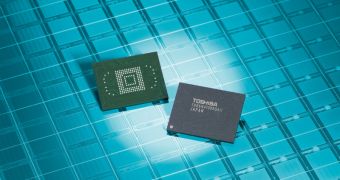It looks like Toshiba tried its hand at hybridization when it built its newest eMMC devices, having decided to give these NAND Flash chips the DDR (double data rate) interface.
There are multiple types of semiconductors and, for each type, there are subtypes and more subtypes still, each better suited to a specific task.
In this case, the type of memory is NAND Flash, while the subtype that Toshiba focused on was eMMC.
Aimed at embedded applications, Toshiba's eMMC devices are now being manufactured on the 24nm process technology.
The latest to be put together by Toshiba were given the DDR interface, particularly the toggle-mode double data rate.
The storage capacity ranges from 2 GB to 128 GB as up to 16 pieces of 64 Gb (8GB) NAND chips can be combined.
According to the press release that Toshiba issued last week, the company is actually the first who managed to cram 128 GB (those 16 64Gb chips) into a 30 micrometer-thick package.
“The utilization of our new toggle-mode DDR NAND die at 64Gb density is key to enabling our eMMC to support the higher performance, and smaller, thinner packages that customers desire,” said Scott Beekman, senior business development manager, mobile communications memory for Toshiba America Electronic Components.
“For example, our 128GB e-MMC can now be supported in a smaller 14x18 package, which many space conscious applications can support."
8 GB, 16 GB, 32 GB and 64 GB eMMC devices should already be sampling and are compliant in full with the JEDEC e-MMC version 4.41 standard.
Mass shipments should start in the third quarter and other data densities should be available later on as well (2GB in the first quarter of 2012, 4 GB in the fourth quarter of 2011, etc.). The full list of prices and ETAs can be seen here.

 14 DAY TRIAL //
14 DAY TRIAL //